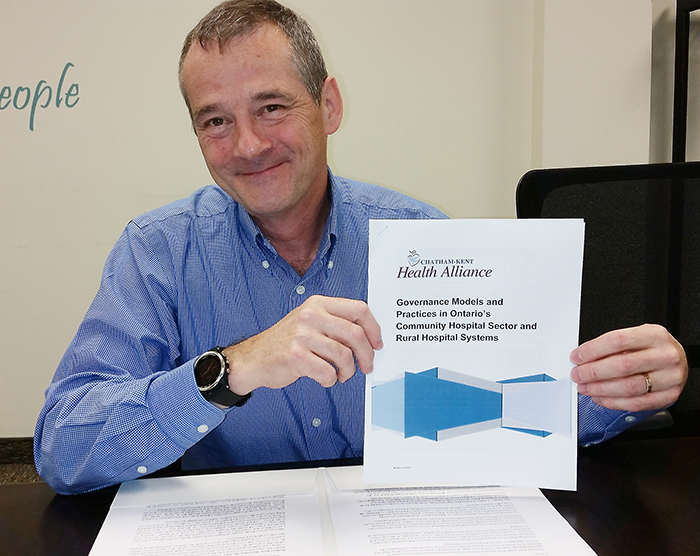
It’s taken more than a year, but the provincially appointed supervisor for the Chatham-Kent Health Alliance has released his governance plan for the alliance’s future.
At a press conference Thursday, Rob Devitt reiterated the commitment to the two-site model – with both the Chatham and Wallaceburg hospital sites remaining strong and viable – but under one governance structure.
And that one hospital board will be comprised of people with the necessary skills to oversee the hospitals’ administration, Devitt said.
Dr. Pervez Faruqi, chief of staff at the CKHA, said the one-governance model makes the most sense for everyone.
“There is no distinction between Wallaceburg and Chatham for physicians. Most physicians work at both sites,” he said. “It’s simply logical to have one corporation moving forward.”
The commitment to the two sites, complete with functioning 24/7 emergency departments, is something the former Public General and St. Joseph’s hospital boards didn’t believe in.
Meanwhile, the Sydenham District Hospital Board was selected by a pay-to-vote structure Devitt said was out of touch with the times.
“We’ve seen in Ontario over the last few years a big shift to where directors and the corporation need to focus on skills,” he said. “When I started 20-plus years ago, most had paid models.”
That paid structure saw citizens paying a modest fee to be part of a group that elected people to sit on the hospital board, which is how things worked for the Sydenham Hospital Board.
The new board will be 12-voting-members strong and will be selected by Devitt, with the assistance of a headhunting firm. A committee, made up of several medical staff, CEO Lori Marshall, one member of the Rural Health Advisory Committee and three members of the public, will advise.
Devitt in the past said choosing the governance structure wouldn’t be easy. It took him 15 months to come to the governance conclusion. But he admitted there were more pressing matters in the way when he took over supervision of the CKHA in September of 2016.
“You diagnose the issues and figure out the right treatment plan,” he said. “And just like with a patient, you diagnose the most critical needs first.”
For the CKHA, finances were on life support, while staff morale was in chronic care when Devitt stepped in.
“A year ago, we were looking at every expense to make sure the paycheques wouldn’t bounce,” he admitted.
Today, with a new administration in place and much different spending practices, the alliance boasts a balanced budget.
In terms of what led to Devitt having to be appointed in the wake of a provincial investigator, Bonnie Adamson, examining the dysfunctional nature of the former three hospital boards as well as problems with the day-to-day operations at the alliance, the supervisor said it really came down to two things that were a problem at the governance level.
“One, I haven’t seen the clear articulation of the alliance’s vision,” he said, adding the reality that the alliance is “anchored by two sites” was missing. “A lot of the debate was ‘my site versus your site’ rather than about doing what’s best for the patient. We really need to have one system, but with two sites.”
Devitt said the alliance has shown in the past year it is committed to the two-site format, investing heavily at the Sydenham District Campus and committing to building a new powerplant on site, as well as expanding services.
He said four new specialty clinics are already underway at the Sydenham campus.
The second major issue Devitt said hurt the old governance structure was the three-board system.
“They had three corporations and three boards. Everything else was integrated,” he said. “This is no different than having three different bosses. That’s a fundamental flaw.”
He understood how board members for each hospital placed the wants and needs of that particular hospital first.
“When you are a director of a corporation, your duty is to that corporation,” he said. “The system before Bonnie was appointed was working as designed. In effect, there was no system.”
By going with one board and one corporation, Devitt said it is the route that makes the most sense.
“We’re putting in a structure where the evidence says it is the right structure,” he said. “This has to be about the patients.”
He said the changes at the alliance appear to be working well so far, as patient volumes are up and the budget is balanced.
Devitt said he is forwarding his plan to the Erie-St. Clair Local Health Integration Network, and the Ministry of Health and Long-Term Care. He hoped to wrap up the governance model before the end of the calendar year, and anticipates he’ll be out of the affairs of the alliance by April.






